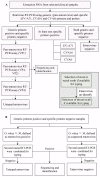Molecular strategy for the direct detection and identification of human enteroviruses in clinical specimens associated with hand, foot and mouth disease
- PMID: 33166321
- PMCID: PMC7652283
- DOI: 10.1371/journal.pone.0241614
Molecular strategy for the direct detection and identification of human enteroviruses in clinical specimens associated with hand, foot and mouth disease
Abstract
Background: Diseases caused by human enteroviruses (EVs) are a major global public health problem. Thus, the effective diagnosis of all human EVs infections and the monitoring of epidemiological and ecological dynamic changes are urgently needed.
Methods: Based on two comprehensive virological surveillance systems of hand, foot and mouth disease (HFMD), real-time PCR and nested RT-PCR (RT-snPCR) methods based on the enteroviral VP1, VP4-VP2 and VP4 regions were designed to directly detect all human EVs serotypes in clinical specimens.
Results: The results showed that the proposed serotyping strategy exhibit very high diagnostic efficiency (Study 1: 99.9%; Study 2: 89.5%), and the variance between the study was due to inclusion of the specific Coxsackie virus A6 (CVA6) real-time RT-PCR and VP4 RT-snPCR in Study 1 but not Study 2. Furthermore, only throat swabs were collected and analyzed in Study 2, whereas in Study 1, if a specific EV serotype was not identified in the primary stool sample, other sample types (rectal swab and throat swab) were further tested where available. During the study period from 2013 to 2018, CVA6 became one of the main HFMD causative agents, whereas the level of enterovirus A71 (EV-A71) declined in 2017.
Conclusion: The findings of this study demonstrate the appropriate application of PCR methods and the combination of biological sample types that are useful for etiological studies and propose a molecular strategy for the direct detection of human EVs in clinical specimens associated with HFMD.
Conflict of interest statement
Hongjie Yu has received research funding from Sanofi Pasteur, GlaxoSmithKline, Yichang HEC Changjiang Pharmaceutical Company, and Shanghai Roche Pharmaceutical Company. This does not alter our adherence to PLOS ONE policies on sharing data and materials. All other authors declare no competing interests.
Figures



Similar articles
-
Validation and utilization of an internally controlled multiplex Real-time RT-PCR assay for simultaneous detection of enteroviruses and enterovirus A71 associated with hand foot and mouth disease.Virol J. 2015 Jun 9;12:85. doi: 10.1186/s12985-015-0316-2. Virol J. 2015. PMID: 26050791 Free PMC article.
-
Development of single-step multiplex real-time RT-PCR assays for rapid diagnosis of enterovirus 71, coxsackievirus A6, and A16 in patients with hand, foot, and mouth disease.J Virol Methods. 2017 Oct;248:92-99. doi: 10.1016/j.jviromet.2017.06.013. Epub 2017 Jun 27. J Virol Methods. 2017. PMID: 28662914
-
A one-step, triplex, real-time RT-PCR assay for the simultaneous detection of enterovirus 71, coxsackie A16 and pan-enterovirus in a single tube.PLoS One. 2014 Jul 16;9(7):e102724. doi: 10.1371/journal.pone.0102724. eCollection 2014. PLoS One. 2014. PMID: 25029500 Free PMC article.
-
Atypical hand-foot-mouth disease in Belém, Amazon region, northern Brazil, with detection of coxsackievirus A6.J Clin Virol. 2020 May;126:104307. doi: 10.1016/j.jcv.2020.104307. Epub 2020 Mar 6. J Clin Virol. 2020. PMID: 32302950 Review.
-
Isothermal nucleic acid amplification for monitoring hand-foot-and-mouth disease: current status and future implications.Mikrochim Acta. 2024 Dec 25;192(1):31. doi: 10.1007/s00604-024-06899-9. Mikrochim Acta. 2024. PMID: 39720958 Review.
Cited by
-
Evaluation of Direct Detection Protocols for Poliovirus from Stool Samples of Acute Flaccid Paralysis Patients.Viruses. 2023 Oct 18;15(10):2113. doi: 10.3390/v15102113. Viruses. 2023. PMID: 37896890 Free PMC article.
-
Metagenomic Surveillance of Viral Gastroenteritis in a Public Health Setting.Microbiol Spectr. 2023 Aug 17;11(4):e0502222. doi: 10.1128/spectrum.05022-22. Epub 2023 Jul 11. Microbiol Spectr. 2023. PMID: 37432120 Free PMC article.
-
HNB-RT-LAMP Coupled with CRISPR/Cas12a for the Simultaneous Detection of Enteroviruses and Enterovirus A71 in a Single Tube.ACS Omega. 2025 Mar 26;10(13):13002-13010. doi: 10.1021/acsomega.4c09729. eCollection 2025 Apr 8. ACS Omega. 2025. PMID: 40224480 Free PMC article.
-
Molecular characterization of echovirus 9 strains isolated from hand-foot-and-mouth disease in Kunming, Yunnan Province, China.Sci Rep. 2022 Feb 10;12(1):2293. doi: 10.1038/s41598-022-06309-1. Sci Rep. 2022. PMID: 35145190 Free PMC article.
-
Enhancing Clinical Nursing Guidance and Optimizing Care Processes for Improved Hand-Foot-and-Mouth Disease Treatment Outcomes.J Multidiscip Healthc. 2025 Jul 9;18:3921-3931. doi: 10.2147/JMDH.S523576. eCollection 2025. J Multidiscip Healthc. 2025. PMID: 40662060 Free PMC article.
References
-
- Tapparel C, Siegrist F, Petty TJ, Kaiser L. Picornavirus and enterovirus diversity with associated human diseases. Infection, genetics and evolution: journal of molecular epidemiology and evolutionary genetics in infectious diseases. 2013;14:282–93. Epub 2012/12/04. 10.1016/j.meegid.2012.10.016 . - DOI - PubMed
-
- Knipe DM, Howley PM. Fields Virology, 6th Edition: Lippincott Williams & Wilkins; 2013.
Publication types
MeSH terms
Substances
Grants and funding
LinkOut - more resources
Full Text Sources

